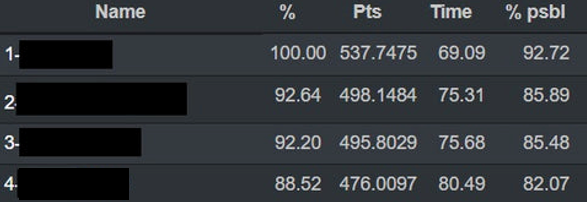Welcome back! In this section we are going to cover Hit Factor (HF) and match points. Be ready for some math. This is often the most confusing topic for new competitors. As Billy Madison once said, “Go on with the chlorophyll.”

Hit Factor and Match Scoring
Hits on target will give the shooter points based on the scoring zone, as discussed in Part II. At the end of the stage, all point values are added up and used to calculate your Hit Factor. HF is simply your total points for the stage divided by your time, or points per second. High hit factor wins the stage. The tough part of HF scoring is figuring out just where to balance speed and accuracy to achieve the best hit factor. Let’s walk through an example of two shooters on a given stage.
In this example, both are shooting Minor PF. The stage requires a minimum of 22 rounds, scoring the best two on paper on 10 USPSA targets and two steel poppers, for a total of 110 points possible. Here are the times and points for each shooter.
Shooter A Shooter B
Time: 12.00 Time: 10.80
A-20 A-16
C-2 C-6
Points: 106 Points: 98
Dividing each shooters’ points by their time, we get a hit factor of 8.83 for shooter A and 9.07 for shooter B. Despite scoring less points, shooter B would take the win due to their overall time being 1.2 seconds faster giving them more points per second.
Stage/Match Points
Now… stage points. Stay with me, we’re almost there.
Hit factor determines the winner of a particular stage, but stage points win matches. Let’s reference our example stage. Because shooter B was the winner of the stage, they would be awarded all points for that stage, 110 points, toward their overall match score. So how many does A get? We have to determine what percentage of the stage winner’s HF that A shot.
8.83 is 97.35% of 9.07, so shooter A gets 97.35% of shooter B’s 110 stage points they were awarded for winning that stage. Shooter A is awarded 107.085 points. USPSA will measure down to four decimal points, but you get the idea.
The stage winner sets the bar and every competitor will be awarded stage points based on their percentage of the high hit factor of that stage. At the end of the match, everyone’s stage points are added together to get their final match score, which determines their standing for the match.

The screenshot above was taken from a recent match where I placed 4/45 overall (hey, we’ve got to own our wins and losses. 1st place was a Grandmaster in other divisions, so I’ll take it!). Names are omitted for privacy.
We can see that the 1st place shooter had a total of 537 match points, an aggregate time of 69 seconds. He scored 92-A, 21-C, 2-D, and 1-M throughout the match. For comparison, I shot 98-A, 16-C, 1-D, and 1-M, but my aggregate time was 11.4 seconds slower. This doesn't tell the whole story of why I lost the match, that would require looking at each stage, but it gives you an idea of how your time and accuracy plays into your overall score and final placing for a match. Essentially, I was only slightly more accurate, and he was considerably faster than me, an average of around two seconds per stage.
Ultimately, it takes getting some matches under your belt and looking at your scores to have a thorough understanding of USPSA's scoring system. If you’re a knuckle dragger like me, thanks for sticking it out to the end. Check out Part IV where we wrap up with divisions and classification.
Current USPSA rules (as of this writing) are available at the link below.
USPSA Rulebook: https://uspsa.org/viewer/2024-USPSA-Competition-Rules.pdf
